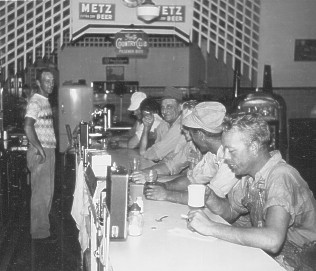Looking northward from the intersection of Morganville's Main Street and Johnson Street in photos from 1948 (left) and 2013
While Carson had to write a 4,500-word play in about two weeks, locate and choose costumes, aid with the selection of
music, locate stage lights and a public address system, generate publicity and attend to any number of other details,
she was also undergoing treatment for cataracts. To read with ease, she would often sit next to a window, where
reflected sunlight would fall directly on the page. So it is not surprising that the final script contains little
more than the essential text spoken by the play's narrator. One of the few exceptions is at the very beginning: "Spot
light on Mrs. S. A. Anderson. Stage almost dark (soft piano music)."
The script, titled "Message to Fèves," was crafted to meet several goals. One was to be entertaining.
Telling the story of Morganville's birth would satisfy the curiosity of both their soon-to-be French friends and,
quite possibly, do the same for the youngsters of Morganville as well. For the older generation, it would be a trip
down memory lane.
But Carson also wanted to counter the effect of Hollywood movies sent abroad during the world-wide economic Depression
of the 1930s. They had left many Europeans with the impression that most Americans were rich. She wanted the citizens
of Fèves to know about the difficulties those in Morganville had experienced with tornadoes, floods and the Native
Americans. She wanted the people of Fèves to understand that the citizens of Morganville were, in most regards,
just like them, but without the misfortunes of the recent war. And she wanted them to know that just as the people
of her small prairie village had endured and come to thrive, so too would the people of Fèves.
It was also important to emphasize how interconnected the world had become. This would answer for Carson's neighbors why
they should care what was happening half a world away, while simultaneously letting the people in Fèves know why these
people in far-away Kansas were holding out their hand. She did that by noting in part that everyone now used products
such as coffee, tea, chocolate and rubber that came from far beyond America's shores. War, a continent away, could
have an effect on Morganville. In her discussions with McKee, Carson observed, "For a while in World War I, we tried isolation,
but war reached out and found us anyhow. In [World War] number two, there wasn't a theater of the war where some
Morganville life didn't hang in the balance. Four never came back."
Carson's play began by describing what the area was like before the first white settlers arrived, about animals that one time were at home in Clay County and how things changed as settlers arrived, bringing their cultures and talents from diverse places. And after telling how Morganville had come to thrive, she compared it to their adopted city and then asked, as good Christians or just as humans, could they stand by and do nothing about the inequity.
The Metz Beer signs in the West Side Diner were not connected with the adoption, but refer to a brewery in Omaha, Nebraska.



